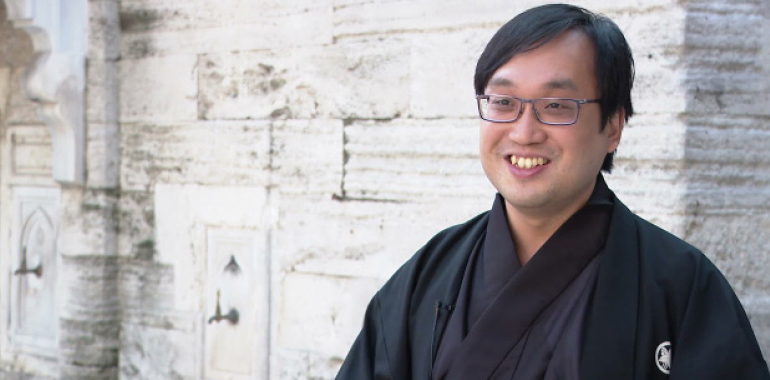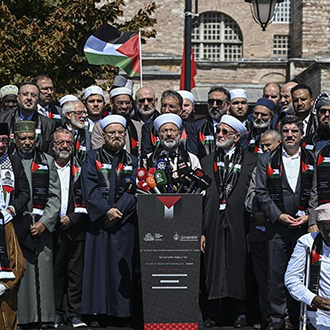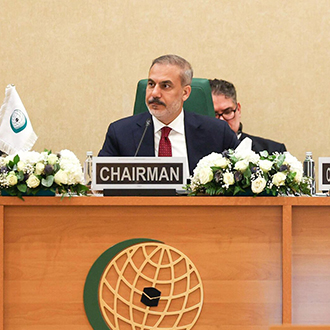He said, “I missed her so much. I kept wondering where she had gone and how I could see her. Now her life has become knowledge and she dwells in your heart and will be with me. In her place, I will be your sensei (teacher).”
Later, Professor Hasan introduced me to Muslims from various countries, including Malaysia, Indonesia, England, Syria, and Egypt. He taught me that tawhid is one but its expression is diverse. I had an image of Muslims as people living in the Middle East, so I was surprised at the variety of languages and cultures that exist within Islamic civilization.
Then in the summer of my sophomore year, I went to Cairo with Professor Hasan for an Arabic summer program, where he said to me, “Why don't you take this opportunity and convert to Islam?”
Thinking back, I think the seed of faith had been dwelling in me since I read Ustadha Khawla's book. I had no resistance to his proposal. While not declaring it openly that day I embraced the faith of Islam in my heart.
What kind of differences did you experience in your relations with your family or close friends after converting to Islam? What aspect of your life has changed the most since you converted to Islam?
When I became a Muslim, the Japanese people around me were very understanding and there were no problems.
Those who sincerely pursue traditional Islamic studies have always guided me. They never judge people, believe in the goodness of people, and sacrifice themselves to help others. The beauty of Islam is that its scholarly traditions guide people. In the end, what matters is education and cultivation.
Which aspect of Islam has affected you the most?
I do not like the expectation of someone's story of being impacted by a certain religion and converting. Human life does not need that kind of Hollywood movie drama. Sometimes people are naturally led to something. Conversion is a start, not a goal. There is no point in focusing on it.
How did you decide to live in Turkey, what effects did this decision have on your life?
I came to Turkey to continue my research on Ottoman tasawwuf after my PhD.
How did you decide to work in the field of Sufism?
Japan has various values and cultures that shaped Japanese society, such as the kimono, tea ceremony, and Buddhist classics. I wanted to study the history and intellectual traditions of Islamic civilization to consider from a broader perspective how to preserve Japanese culture in the future. In this sense, I thought that Islamic studies and the spiritual traditions of the Ottoman Empire could provide a very useful perspective.
Islamic sciences during the Ottoman Empire were an intellectual system that created a society embracing people of diverse origins, and tasawwuf created the spiritual foundation of such a society. Japan and Turkey have experienced the process of modernization in a variety of different contexts. They have similarities and differences concerning the preservation of traditional culture and intellectual heritage. I am particularly interested in learning about the history and practice of tasawwuf, the spiritual and cultural center of Ottoman society, and its post-modern situation.
I have noticed that tasawwuf has a surprising number of similarities in the practical aspects of Japanese culture, such as the various practices of purifying the heart, called suluk in tasawwuf, which were practiced in many lands with various methods. The Mevlevi Sufi order that developed in Anatolia, for example, used cooking and kitchen duties as a spiritual practice. Tariqa masters appoint their disciples to various kitchen-related positions to develop their spirit. The same tradition existed and continues in Japanese Zen Buddhism. At the Eiheiji, a Soto Zen temple in Fukui Prefecture, Japan, the food is prepared by a practitioner appointed to the position of Tenzo. It is a process that helps suppress one's ego and cultivate a spirit of service to others.
You have visited many countries. What can you say about the various interpretations of Islamic civilization in different countries?
I was rather surprised by the fact that there is little knowledge of East Asia within the Muslim community. Islam is a universal religion, but the Muslim community is oblivious to the fact that its universal teachings are manifested with local particularities. For example, in his work “On the Five Colors of Islam” (Aux cinq couleurs de l’islam), orientalist convert Vincent Mansour-Monteil divides Islamic civilization into five categories. These are different Islamic traditions manifested in Turkey, Africa, Malay, Arab and Indo-Persian regions. But I think there is an important gap in those categories.
For instance, I am a Japanese Muslim convert. Then, according to this theory, where is an East Asian person standing? Is there no such thing as a Sino-Islamic culture, or is this something that has just begun to flourish? In fact, the Sino-Islamic civilization can be one of the oldest cultures in the Islamic tradition, since there are [accounts] that one of the Companions reached China. Unless we know Chinese Islamic history, we cannot fully grasp the tradition of Islamic civilization.
And after converting to Islam, I found myself thinking, “What does it mean to be a Japanese Muslim?”, “Am I going to be a Muslim like a Turkish, an Arab, or a Malay?” I also wondered if accepting Islam meant abandoning my past as a Japanese and my Japanese culture. After reading different sources, it was the Sino-Islamic books which surprised me the most because these books were as if they were written by a Muslim Samurai! Afterwards, I felt that if we could revive this valuable heritage, it would be easier for us to build Japanese-Islamic culture.
Therefore, learning Sino-Islamic culture is necessary not only to fill the academic gap, but also to develop a correct method (usul) for Japanese Muslims. An interesting point about Islamic civilization is that Islamic ideals acquired linguistic expressions suitable for their context in various regions. For example, in the Malay region, shadow plays were used by Sufi saints as a means of teaching Islamic history and thought to the people. Many manuscripts written in various languages of the Malay region such as Malay, Javanese, and Sundanese also remain. The vision of Islam is universal, but the method of experiencing Islam is diverse. If this is the case, then there should be a method for Japanese people to experience Islam. I would like to learn about the history of Islam in East Asia as a key to understanding such a method.
What can you tell us about your tea ceremony project that is currently underway?
It is said that the tea ceremony is the art of compassion for others and the process of accepting one's imperfections. This is precisely the philosophy described in the spiritual ascent process (maqamat) of tasawwuf.
I first noticed the similarities between the tea ceremony and Ottoman Sufi culture when I was learning about the culinary culture of the Mevlevi Order mentioned above. The spirituality that elevates the act of serving food and drinks to others to a sophisticated culture and expresses it as a symbol of overcoming the ego and altruism is a common theme between Japanese culture and Ottoman Sufi culture.
In the Sufi training lodges in Anatolia, you can see calligraphy with the Ottoman Turkish word hiç on the wall. Hiç means nothingness. It represents man's insignificance and powerlessness compared to God, but also the state of mind of a Sufi who has eliminated his selfishness and cultivated a heart of devotion to others. The Sufis of Anatolia were not training to become something but to teach their spirit to become nothing.
The Wabi-Sabi of the tea ceremony has a similar vision. In the tea ceremony, a deep black tea bowl with no decoration is preferred as a symbol of the heart embodying nothingness. Sen no Rikyu, the great master of the Japanese tea ceremony, described the black color of a tea bowl as “the color of embracing eternity”. It refers to a heart that is not distracted by a false world or ego, but is focused on the invisible reality behind it.
The black color of a tea bowl for tea ceremony is the state of hiç that the Sufi aims for.









